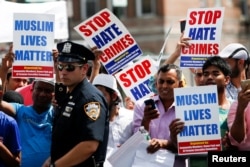By all accounts, hate crimes are rising in the United States. From an increase in the number of attacks on hijab-wearing Muslim women to threats made against Jewish community centers earlier this year, all indications suggest hate-motivated offenses are on the rise.
But their true extent remains a puzzle, in part because of poor data collection.
Now, policymakers, worried that hate crimes are woefully underreported, are mulling prescriptions to improve the quality of crime reporting.
Legislative action
In March, two Democratic lawmakers, Senator Richard Blumenthal and Representative Don Beyer, introduced legislation that aims to aid the FBI in its transition to a more comprehensive crime reporting system known as the National Incident Based Reporting System (NIBRS).
In May, the Senate Judiciary Committee held a hearing on combating religious hate crimes, with several Democratic members pledging support for making hate crime reporting mandatory.
And last week, Attorney General Jeff Sessions told a hate crimes summit in Washington that he’d tasked a newly formed subcommittee on hate crimes with finding ways to improve training, community outreach and data collection.
“There are very real consequences to this lack of comprehensive reporting,” Jonathan Greenblatt, CEO of the Anti-Defamation League, told the Senate panel. “It is well documented that victims are far more likely to report a hate crime if they know a special reporting system is in place, if they believe the police are ready and able to respond effectively.”
Recent surge
The FBI defines a hate crime as a “criminal offense against a person or property motivated in whole or in part by an offender’s bias against a race, religion, disability, sexual orientation, ethnicity, gender or gender identity.”
Between the Nov. 8 presidential election and March 31 this year, the Southern Poverty Law Center recorded 1,863 bias incidents and hate crimes. And police department data compiled by California State University show double-digit increases in several cities this year.
Historically, though, many hate crimes have gone unreported. Take the FBI’s Uniform Crime Report (UCR), the bible of crime statistics since 1930. The bureau started including extensive hate crime data in the annual report after Congress mandated it with the passage of the 1990 Hate Crime Statistics Act.
But participation in the program was made voluntary, and thousands of the nation’s 18,000 law enforcement agencies have chosen either to not participate or not to report hate crimes. The result is serious undercounting of hate crimes.
While the FBI’s most recent report, released in November, showed 5,850 bias-motivated offenses in 2015, a national survey conducted by the Bureau of Justice Statistics, another arm of the Justice Department, estimated that 250,000 hate crimes took place in 2015.
The gap between the two sets of figures underlines the magnitude of underreporting, said Brian Levin, director of the center for the study of hate and extremism at California State University at San Bernardino.
“This is not only because of an absence of trainings, model policies, executive leadership, outreach and coordination, but also because the reporting system itself is not mandatory,” Levin said.
Last week’s hate crimes summit focused in part on data collection, said Levin, who presented his latest data to the attendees. “The advocacy community is very much in favor of mandatory reporting,” he said.
Crime reporting
The FBI has touted Tennessee as a leader on crime reporting, the only state that requires all law enforcement agencies to report hate crimes to the state’s bureau of investigations.
“We have a 100 percent participation rate,” Tennessee Bureau of Investigation spokesman Josh DeVine said. “All agencies in Tennessee are currently in compliance with” the state’s crime reporting system.
To ensure participation, the agency provides regular outreach and training to the state’s more than 550 law enforcement agencies, DeVine said.
“What we’re trying to do in talking about hate crime statistics in Tennessee is to create a culture and a climate where people realize that even one of these is a problem and it’s not something we stand for as Tennesseans,” DeVine said.
The FBI has long acknowledged the limitations of its voluntary UCR reporting system.
“There are jurisdictions that fail to report hate crime statistics,” then-FBI Director James Comey said in a speech at the Anti-Defamation League in 2014. “Others claim there were no hate crimes in their community, a fact that would be welcome if true.”
In 2015, while nearly 15,000 law enforcement agencies participated in the data collection, 12 percent “actively reported” on hate crimes, Greenblatt said. Among nonreporting jurisdictions: 66 cities each with a population of more than 100,000.
“It is absolutely clear that the ... data we have now significantly understates the true number of hate crimes committed in our nation,” Greenblatt said.
Democrats, Republicans
While Democrats have voiced support for a mandatory crime reporting system, Republicans remain skeptical.
“If law enforcement is unwilling to call a crime a hate crime, I don’t see how a change in the law to require reporting of hate crime will change the current situation of spotty data and missed opportunities,” Senate Judiciary Chairman Charles Grassley said.
The FBI plans to replace its UCR crime reporting systems with the NIBRS by 2021.The NIBRS is a more comprehensive system, but 28 years into its launch, participation in it remains low, with just 15 states submitting all their crime data via the NIBRS.
“Moving to an incident-based collection provides richer data and the ability to really dig in and understand the characteristics of incidents and victims to a greater degree,” Lynn Langton of the Bureau of Justice Statistics said.















